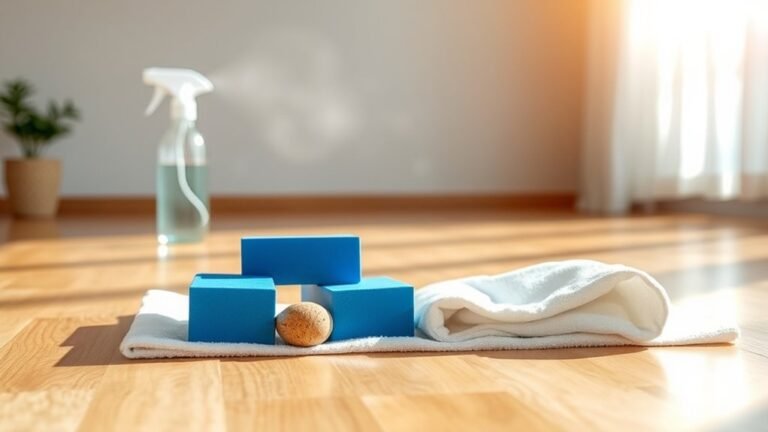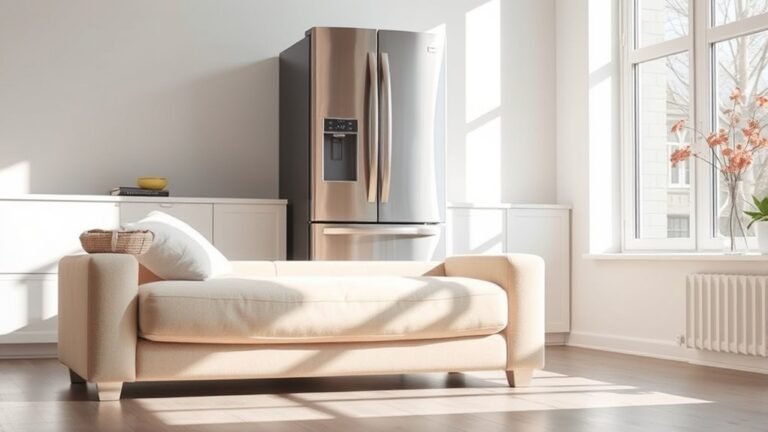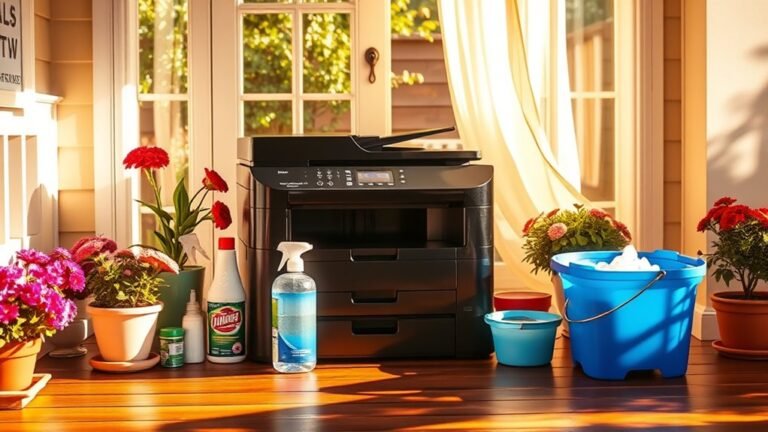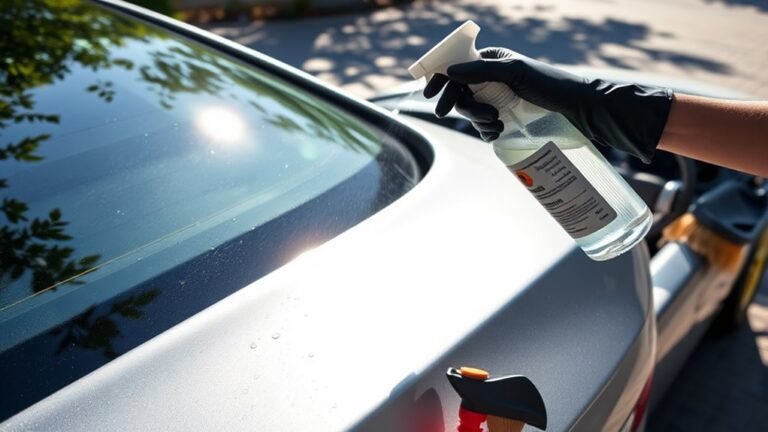How to Use Ozone Generators for Odor Removal
To use an ozone generator for odor removal, first clear the space and remove pets and people. Place the unit centrally and seal windows and doors to contain the ozone. Run the generator based on odor severity, then ventilate the area thoroughly for at least 30 minutes using fans to disperse ozone. Avoid direct exposure during treatment and airing out, since ozone can be harmful. If you want to make sure you’re using it safely and effectively, there’s more to contemplate.
Understanding How Ozone Generators Work

Before you start using an ozone generator, it’s important to understand how it works. You see, ozone chemistry revolves around the unique molecular structure of ozone (O3), which consists of three oxygen atoms bonded together. This extra oxygen atom makes ozone highly reactive, allowing it to interact with and break down odor-causing molecules. When you switch on an ozone generator, it produces ozone by splitting oxygen molecules (O2) and recombining them into O3. This powerful oxidizer then targets pollutants and odors at a molecular level, neutralizing them rather than just masking the smell. Knowing this helps you appreciate how ozone generators give you the freedom to cleanse your environment thoroughly and efficiently, without relying on temporary fixes or harsh chemicals.
Identifying Common Odor Sources
Odors can come from a variety of sources, and identifying them is key to effective removal. Before you start using an ozone generator, you need to pinpoint exactly what’s causing that stubborn smell. Whether you’re identifying pet odors or eliminating smoke smells, knowing the source helps you target the problem with precision.
Pinpointing the exact source of odors is essential before using an ozone generator for effective removal.
Common odor sources include:
- Pet dander and urine stains
- Cigarette smoke lingering in fabrics
- Mold and mildew in damp areas
- Cooking smells trapped in upholstery
- Trash bins and spoiled food
Preparing the Space for Ozone Treatment
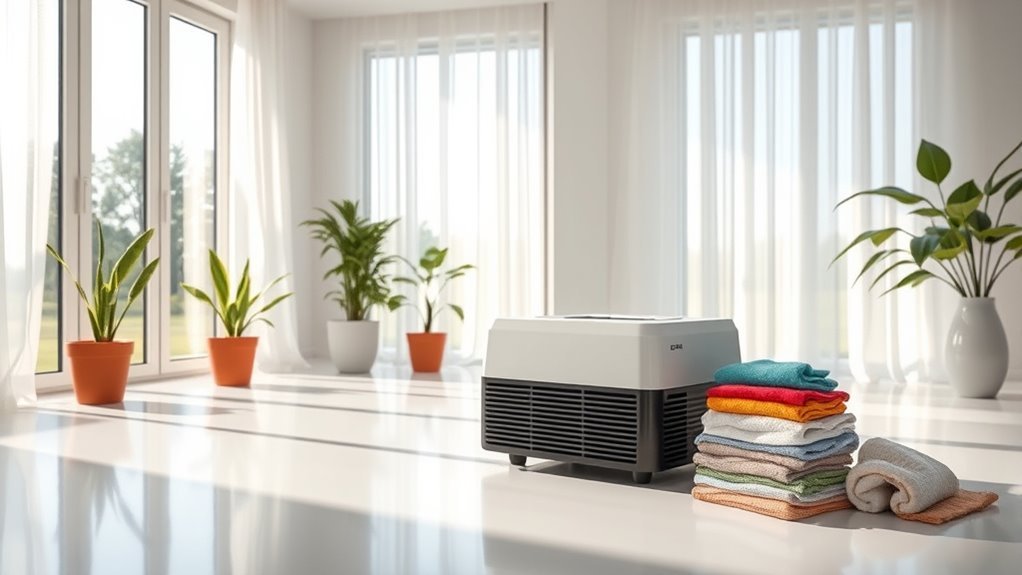
Before you start ozone treatment, make certain to remove or cover any sensitive items in the room. You’ll also want to keep windows and doors open to allow proper ventilation before and after the process. These steps help guarantee the ozone works effectively and safely.
Clear Room Contents
To get the most effective ozone treatment, you’ll want to remove as many items from the room as possible. Clearing furniture and removing clutter not only allows the ozone to circulate freely but also protects your belongings from potential damage. Picture a clean, open space where the air can flow without barriers. Start by taking out:
- Chairs, sofas, and tables
- Rugs and carpets
- Curtains and drapes
- Personal items like books and toys
- Electronics and plants
Ensure Proper Ventilation
While setting up your space for ozone treatment, you’ll want to make certain there’s proper ventilation to avoid ozone buildup and guarantee safety. Effective ventilation techniques are essential; they allow ozone to dissipate once the treatment ends, keeping your environment safe and fresh. You can achieve this by opening windows and doors or using fans to enhance airflow management. Make sure to plan how air moves through the space so ozone doesn’t linger in pockets where it might cause harm. Proper airflow management supports a quick, thorough odor removal process while protecting your freedom to use the area safely afterward. Remember, controlling ventilation isn’t just about safety—it’s about maximizing ozone’s effectiveness and reclaiming your space with confidence.
Setting Up Your Ozone Generator
Before you turn on your ozone generator, make sure to place it in a central spot for even ozone distribution. Prepare the room by sealing windows and doors to keep the ozone contained. Finally, set the power level and timer according to the size of the space and severity of the odor.
Placement Tips
Although ozone generators are powerful tools for odor removal, their effectiveness largely depends on where you place them in the room. For ideal generator placement, you’ll want to take into account the surrounding furniture to guarantee ozone circulates freely. Avoid placing the unit behind large items that block airflow or in corners where ozone can get trapped. Position it centrally if possible, so every part of the room gets treated evenly. Here are some placement tips to set you free from stubborn odors:
- Place on a sturdy, elevated surface away from fabrics
- Keep away from electronics and plants
- Provide clear space around the generator for airflow
- Avoid direct contact with walls or furniture
- Choose a spot near the odor source without obstruction
This setup helps you harness the full power of ozone without limits.
Room Preparation
Since ozone generators release strong oxidizers, you’ll want to prepare the room properly to maximize safety and effectiveness. Start by performing a thorough odor assessment to identify the source and intensity. Next, consider the room layout—remove or cover sensitive items and guarantee good air circulation. Seal doors and windows to contain ozone within the space for better results. Here’s a quick guide to help you set up:
| Step | Action | Tip |
|---|---|---|
| 1 | Odor Assessment | Identify odor hotspots |
| 2 | Clear Room | Remove pets and plants |
| 3 | Seal Openings | Close windows and doors |
| 4 | Arrange Generator | Place centrally for airflow |
| 5 | Ventilate After Use | Air out room before re-entry |
Proper room preparation guarantees freedom from odors without compromising safety.
Power and Timer Settings
Choosing the right power and timer settings is key to effectively eliminating odors without overexposing the space to ozone. You’ll want to adjust the power settings based on the room size and odor intensity, ensuring the generator runs just long enough to clear the air. Timer adjustments let you control the exposure, giving you freedom to set it and forget it without worrying about safety.
Think about:
- A low power setting for small rooms or mild odors
- Higher power for larger spaces or stubborn smells
- Short timer bursts for quick refreshes
- Longer runs for deep odor removal
- Using a remote or app for easy timer control
With these settings dialed in, you’ll reclaim your space’s freshness safely and efficiently.
Recommended Exposure Times for Different Odors
When dealing with various odors, the exposure time you allow for your ozone generator to work can make all the difference. Different smells require different recommended exposure times to guarantee effective elimination without wasting energy or risking damage. For example, mild odors like cooking smells may only need 30 minutes to an hour, while stronger odors such as smoke or pet smells often require 2 to 4 hours. Mold odors can demand even longer exposure, sometimes up to 8 hours. Following odor specific guidelines helps you tailor the ozone treatment precisely, giving you control and freedom to refresh your space efficiently. Always adjust based on odor intensity and room size, guaranteeing you hit the sweet spot between thorough removal and safe, effective use.
Safety Precautions When Using Ozone Generators

Using ozone generators requires careful attention to safety to protect yourself and others from harmful exposure. Staying aware of ozone toxicity awareness is essential to enjoy the freedom these devices offer without risking health. You’ll want to follow generator maintenance tips to guarantee the unit works efficiently and safely. Before starting, make sure the area is unoccupied and sealed off. Always use a timer to control exposure time, preventing accidental overuse. Keep a carbon monoxide detector nearby, as ozone can react with certain chemicals. Here are key safety steps to remember:
- Remove pets and people from the treatment area
- Wear protective gear if you must enter during use
- Inspect the generator regularly for damage
- Avoid prolonged exposure to ozone
- Store the generator in a dry, ventilated space
These precautions let you harness ozone power safely and freely.
Ventilating the Area After Treatment
Once the ozone treatment is done, you’ll need to ventilate the area thoroughly to clear out any lingering ozone. Proper airflow is essential, and you should keep the space open for at least 30 minutes to an hour. Make sure to follow safety precautions by staying out during ventilation and avoiding direct exposure to the air until it’s safe.
Importance of Proper Airflow
Although ozone generators are effective at eliminating odors, you’ll need proper airflow to confirm the treated area is safe to re-enter. Mastering airflow patterns and circulation strategies confirms ozone dissipates fully, freeing you from lingering irritants. Without good ventilation, ozone can remain trapped, limiting your freedom to enjoy fresh air. To create effective airflow, you should:
- Open multiple windows and doors to establish cross-ventilation
- Use fans to boost air movement and disperse ozone quickly
- Position fans to push stale air out and draw fresh air in
- Avoid closed or dead-end spaces where air stagnates
- Check that HVAC systems support airflow without recirculating ozone
Duration of Ventilation
Since ozone can linger longer than you’d expect, ventilating the treated area thoroughly is essential before you or anyone else re-enters. The ventilation duration depends on the ozone generator’s strength and the room’s size, but a good rule of thumb is at least 30 minutes to an hour of fresh airflow. Proper airflow management guarantees ozone levels drop safely and odors dissipate completely. Open windows and doors, use fans to create cross-ventilation, and keep air moving steadily. This helps flush out residual ozone efficiently, freeing the space for your return. Don’t rush this step—adequate ventilation duration maximizes odor removal while preserving your freedom to breathe easy afterward.
Safety Precautions During Ventilation
While ventilating after using an ozone generator, you’ll want to take certain safety precautions to protect yourself and others. Proper ventilation techniques guarantee fresh air replaces ozone, restoring safe air quality. Here’s what you can do to stay safe and free:
- Open all windows and doors wide to maximize airflow
- Use fans to push ozone out and pull fresh air in
- Avoid re-entering the treated space until ozone levels drop
- Keep pets and children away during ventilation
- Monitor the air quality with an ozone meter or detector
Frequency of Ozone Generator Use
When you’re deciding how often to run an ozone generator, it largely depends on the severity of the odor and the size of the space. You’ll want to adjust the ozone frequency to match these factors—stronger odors or larger areas may need longer or more frequent treatment intervals. Typically, short sessions spaced out over several hours or days work best to avoid overexposure and guarantee effective odor removal. Don’t just set it and forget it; monitor the space after each session to see if the odor has diminished. This approach gives you the freedom to tailor each treatment to your unique situation, optimizing results without unnecessary risk. Remember, balancing ozone frequency with proper ventilation lets you enjoy a fresher environment safely and efficiently.
Limitations of Ozone Generators in Odor Removal
Even though ozone generators can be effective against many odors, they have clear limitations you should know about before relying on them. Their effectiveness limitations mean they don’t work equally well on all smells, especially those deeply embedded in fabrics or porous materials. Plus, ozone can irritate your lungs and eyes, raising health concerns if used improperly. You should also consider:
- Ozone’s inability to remove all types of odors instantly
- Potential damage to rubber, plastics, and electronic components
- Necessity to vacate the area during treatment
- Limited effectiveness in large, open spaces
- Risk of lingering ozone residue causing discomfort
Understanding these limits helps you use ozone generators safely while enjoying the freedom of a fresher environment.
Combining Ozone Treatment With Other Cleaning Methods
Since ozone generators alone can’t tackle every odor or surface effectively, combining them with other cleaning methods can boost your results. You’ll find that using ozone synergy—pairing ozone treatment with thorough vacuuming, steam cleaning, or using natural deodorizers—enhances cleaning effectiveness considerably. Start by removing physical dirt and debris, then run your ozone generator in an unoccupied space to neutralize lingering odors. This layered approach frees you from relying solely on ozone, which can struggle with heavy or embedded smells. By integrating these methods, you not only maximize odor removal but also protect surfaces and the air you breathe. Embracing this ozone synergy gives you more control and freedom in maintaining a fresh, clean environment without overdependence on any single solution.
Frequently Asked Questions
Can Ozone Generators Remove Mold Spores From the Air?
Oh sure, ozone generators are just the miracle cure for mold spores floating around your home—if only it were that simple! While they do help with air purification and can reduce some airborne mold, relying solely on them for mold remediation isn’t the freedom you want. Mold hides in surfaces, and ozone can’t reach it there. To truly reclaim your space, combine ozone with thorough cleaning and professional help for real, lasting freedom from mold.
How Do Ozone Generators Affect Indoor Plants?
You should know that indoor plants are quite ozone sensitive, so using ozone generators around them can harm plant health. Ozone can cause leaf damage, stunt growth, or even kill your plants if exposure is prolonged. To protect your green friends, avoid running ozone generators in the same room or guarantee they’re removed during treatment. This way, you keep your plants thriving while managing air quality safely.
Are Ozone Generators Safe for Use Around Pets?
You shouldn’t use ozone generators around pets because ozone exposure effects can be harmful to their respiratory systems. Pets are more sensitive than humans, so pet safety considerations are essential. To keep your furry friends safe, run the generator in an unoccupied space and ventilate thoroughly before letting pets back in. Taking these precautions helps you enjoy odor-free freedom without risking your pets’ health.
Can Ozone Generators Damage Electronic Devices?
You’ll want to be cautious with ozone exposure around your electronics because some devices have electronic sensitivity and can get damaged. Ozone is a strong oxidizer, and prolonged exposure might degrade plastics, rubber, or internal components. To keep your freedom intact without risking costly repairs, it’s best to remove or cover sensitive electronics when running an ozone generator. That way, you protect your gear while still enjoying fresh air.
What Maintenance Is Required for Ozone Generators?
Funny enough, just like you wouldn’t skip car checkups, ozone generator maintenance is essential. You’ll want to perform routine inspections—checking filters, cleaning the unit, and ensuring no ozone leaks. This keeps your device running smoothly and safely, giving you freedom from pesky odors without worry. Neglecting these steps can reduce efficiency or cause damage, so treat your ozone generator like a trusted companion on your path to fresh air.

